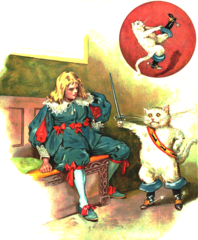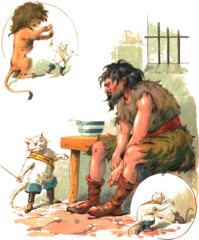
Thursday, June 4 is Hug-A-Cat Day — which, according to Koa Kat, makes it the perfect time to tell two charming stories about cats.
The Owl & the Pussy-Cat
The Owl and the Pussy-Cat is a nonsense poem written by Edward Lear (1812-1888) and first published in 1871.
The Owl and the Pussy-cat went to sea In a beautiful pea-green boat, They took some honey, and plenty of money, Wrapped up in a five-pound note.
This illustrated rendition of the entire poem takes less than two minutes to describe the unlikely marriage of Owl and Pussy-Cat.
Puss-in-Boots
Puss-in-Boots, also called The Master Cat, is about a cat who decided to make his master’s fortune, an altruistic goal not normally credited to a cat. It must be noted that the cat’s good fortune relies upon his master’s success.
The story begins with an inheritance. A miller had three sons. When he died, he left the mill to the oldest son and the mules to the second son. There was nothing left for the youngest boy except a cat that was good for nothing except perhaps a meal and a muff made of his fur.

The cat hears heard his master’s complaint, and claims that if he could have a bag and a pair of boots so he could scamper in the brambles, the master would find he didn’t have such a bad inheritance after all.
The cat puts on his new boots, winds the bag around his neck, goes into a rabbit warren, and lies down as if dead. A foolish rabbit jumps in the bag to investigate treats the cat left inside. The cat gives the rabbit to the king as a gift from his master, the Marquis of Carabas. This goes on for several months. The cat catches game, gives his kill to the king, and gives credit to his young master. The king never seems to question how or why the cat wears boots.
One day, the king announces that he is going to take a carriage drive with his daughter. The cat hurries to his master and persuades him to remove his clothing and enter the river. As the carriage passes, the cat begins to yowl for help.

When the king stops, the cat tells him his master was bathing in the river when a robber took his clothes. The king retrieves the young man from the river, gives him a new suit of clothes, and seats him next to his daughter in the coach. She, of course, falls in love with him.
As a final ruse, the cat tricks an ogre who lived in a castle. The cat told the ogre he’d heard the ogre could change himself into other creatures. The ogre demonstrates his skill by turning into a lion, which rather frightens the cat.

When the ogre takes back his usual shape, the cat asks if he can make himself small, like a mouse. The ogre complies. The cat kills and eats the mouse. When the king’s carriage arrives at the castle, the cat welcomes him in the name of his master.
Eventually, the cat’s master marries the princess, and the cat enjoys life as a lord.
The White Cat and Puss-in-Boots pas de deus illustrates a whimsical variation on the story. The dance interlude from Act III of Sleeping Beauty is performed here by the Royal Ballet in the 2011/12 season
I hope you enjoyed these Cat Tales.
🐈 🐈 🐈
Illustrations
Photo of Koa Kat by Author
Puss in Boots, 1921.
Puss in Boots with his Master and with the Ogre. Polski: ilustracje do książki “Kot w butach” publikacja Księgarni Konstantego Trepte Warszawa 1900
Puss in Boots by Charles Perrault.

Sandra Wagner-Wright holds the doctoral degree in history and taught women’s and global history at the University of Hawai`i. Sandra travels for her research, most recently to Salem, Massachusetts, the setting of her new Salem Stories series. She also enjoys traveling for new experiences. Recent trips include Antarctica and a river cruise on the Rhine from Amsterdam to Basel.
Sandra particularly likes writing about strong women who make a difference. She lives in Hilo, Hawai`i with her family and writes a blog relating to history, travel, and the idiosyncrasies of life.

